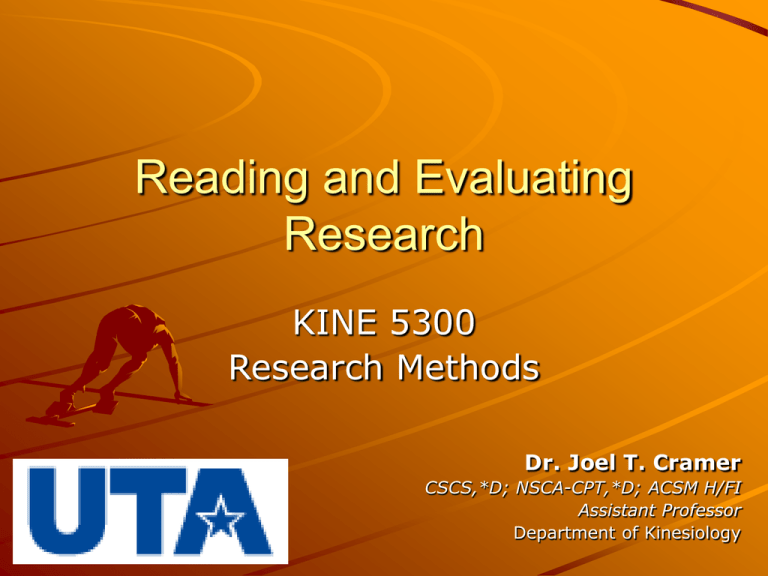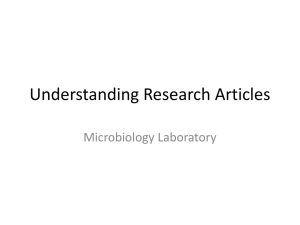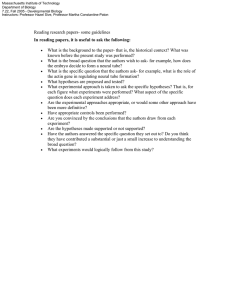Reading and Evaluating Research KINE 5300 Research Methods
advertisement

Reading and Evaluating Research KINE 5300 Research Methods Dr. Joel T. Cramer CSCS,*D; NSCA-CPT,*D; ACSM H/FI Assistant Professor Department of Kinesiology General Outline Component parts of a research article – Introduction – Methods – Results – Discussion – References Evaluating a research article Table 6.1 Preliminary Information – – – – Title Authors and organization affiliation Acknowledgements (if any) Abstract – – – – Background information and literature review Rationale for study Problem statement (purpose statement) Hypotheses or research questions – – – – Participants Instrumentation Procedures Statistical Analysis Introduction Methods Results – Presentation of data Discussion – Conclusions – Recommendations References Appendix (if appropriate) Preliminary Information Title – Usually ~15 words – Important for indexing (NLM) Authors’ names and affiliations – Contact info for corresponding author Acknowledgements – Can also be at the very end of the paper – People who helped, funding agencies Preliminary Information Abstract – Typically 150 – 300 words long – Contains very brief summaries of each section of the “full text” article: Introductory Statement (if any) Purpose Statement Abbreviated Methods Abbreviated Results Conclusion and Application Statement Preliminary Information Key Words – Important for indexing (NLM) Introduction Background Information – Purpose of Intro is to “build a case” – Well-written Intro contains: Definitions of concepts and terms Review of relevant literature Statement of the Research Problem Purpose Statement Hypotheses How to Identify Purpose Statement Look near the end of the Intro Look for phrases like: – “The purpose of this study was…” – “This study was designed to…” – “This investigation sought to…” – “The present study explored…” – “The primary aim of this experiment was…” How to Identify Hypotheses Look near the end of the Intro or in a special section designated as “Research Questions” or “Approach to the Problem” Look for phrases like: – “Based on previous studies, ___ was expected to…” – “We hypothesized that…” Methods Required components: – – – – Subjects or Participants Instrumentation Procedures Statistical Analysis Optional components: – Research Design – Variables (independent and dependent) – Validity and Reliability Concept of Methods: – Readers must be able to replicate this study if desired. Subjects or Participants How many subjects? (n=?) Mean ± SD for age, height, and weight What are the delimitations of the subjects? – – – – Athletes or non-athletes Trained or untrained (training status) Active or sedentary Men or women Study was approved by IRB and subjects signed informed consent forms Instrumentation Each piece of equipment used to collect data – Name brand, manufacturer, city, state – User manuals – Specific procedures for using each piece of equipment Readers must be able to replicate Procedures Precise description of any/all interventions (step-by-step) – Exercise testing and/or training – Nutrition consumption – Time of day – …everything necessary for replication Statistical Analysis What specific statistical models were used to analyze the data? – – – – Descriptive T-tests ANOVAs Regression (linear, nonlinear, polynomial) Effect size and power estimation procedures A priori type I error rate (alpha) – α=0.05 Research Design What design was used to conduct this study? – Cross-sectional or longitudinal – Within-subjects or between-subjects – Cross-over, counterbalanced – Repeated measures or randomized block design (Keppel, 1991) – Double-blind, single-blind Results A very brief section Can often be done in its entirety by a Table or Figure or both Presentation of the data Explanation of the decomposition of the statistical models Reporting the type I error rates Reporting the mean values, SD, SEM, % change, and effect sizes Discussion Purpose is to summarize the results and interpret them relative to the field of study – Each paragraph or subsection of the discussion deals with one or two dependent variables Brief re-statement of what others have found Summary of what the present article found Authors’ interpretation/integration of the findings Hypothesize regarding the findings Recommend or apply Suggest extensions Discussion usually ends in a Conclusive paragraph Reference List Some journals limit references to 30 or 40 – Usually due to page limits Review articles often have 100-200 references Need to be in the format indicated by the “Instructions for Authors” Instructions for Authors Every journal must have instructions for potential authors – Some journals are more definitive than others ECN, JSCR, RQES – 1 page instructions JAP, MSSE, new JSCR - ~12-15 page instructions Definitions of Terms Manuscript: – Research paper that is being written or has been written and submitted for publication, but is not yet published Article: – Published research manuscript How are manuscripts written? Methods section – 1st Results section – 2nd Discussion – 3rd Introduction – 4th Abstract – last Miscellaneous Info Terminology – Humans = men & women – Animals = male & female – “participants” not “subjects” Many “anomalies” – Approach to the Problem – Practical Applications – Design Evaluating a Research Article Critique Criteria for Article Critiques Some journals provide their criteria for potential authors to review BEFORE they submit Table 6.9 (next slide) Table 6.10 – Excellent checklist Assignment for Next Week Determine a project area – This will be your project that will be due at the end of the semester – Your literature review and research question presentations are in 3 weeks You will be expected to use the guidelines discussed tonight to evaluate the studies you present – Discuss this with me before class next week Read Chapter 4 (103-123) Next week is IRB training module


